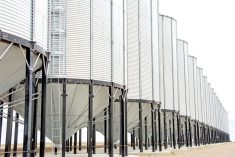CNS Canada — The supply/demand balance sheets for Canada’s wheat, barley and canola crops will likely see some adjustments after Statistics Canada’s stocks report is released Thursday.
The report on grain and oilseed stocks as of Dec. 31, 2015 will provide a better indication of feed usage to date, while also helping confirm the official production estimates.
“The stocks report will confirm the production estimate from December, and provide an idea of the feed usage for wheat and barley,” said Jerry Klassen, manager of the Canadian office for Swiss-based grain trade GAP SA Grains and Produits.
Read Also

China buys U.S. soybean cargoes ahead of Trump-Xi meet, sources say
China’s state-owned COFCO bought three U.S. soybean cargoes, two trade sources said, the country’s first purchases from this year’s U.S. harvest, shortly before a summit of leaders Donald Trump and Xi Jinping.
Non-durum wheat stocks will be watched especially closely this year, he said, as production was down and exports are running ahead of the year-ago level, which could eventually lead to a historically tight carryout. The question now is just how much wheat is going into feed channels.
Relatively strong feed wheat prices in Western Canada are believed to be hindering feed usage, but there are also more cattle on feed, which raises some uncertainty over what the official stock numbers will show.
The milder winter has also had an as-yet unknown impact on feed usage, said analyst Mike Jubinville of ProFarmer Canada. While export demand is well reported, he said, the stocks report should help provide a better sense of the domestic demand — especially for cereals.
Canadian all-wheat stocks of 25.6 million tonnes were reported on Dec. 31, 2014. For the current crop year, most industry participants anticipate a number in the 20 million- to 22 million-tonne area.
Feed usage will also be important for barley, with high feed wheat prices likely leading to an increase in barley usage. The weak Canadian dollar has also shut out imports of U.S. corn or DDGs.
The stocks number for barley will help determine the price direction over the remainder of the crop year, Klassen said. A number below the 5.4 million tonnes available at the same point the previous year would be deemed supportive.
For canola, feed usage is not a major factor, but the stocks number will still be watched closely as it provides confirmation of the official production estimate.
“It is going to be a very interesting report, simply because there are a lot of people out there who seem to think the StatsCan crop estimate (for canola) was way too high,” said Ken Ball of PI Financial.
As a result, he said, traders will be looking at the stocks report to see how the numbers line up with their own production estimates.
Klassen said if canola stocks as of Dec. 31, 2015 came in at around 12 million tonnes it would confirm the production estimate of 17.2 million. However, if the stocks fall closer to 11 million, it would imply production was overstated and significantly tighten the supply/demand balance sheet.
Canadian canola stocks on Dec. 31, 2014, came in at 12.6 million tonnes.
“Do the big deliveries mean that farmers are running out, or do they mean that they have too much to deliver?” Winnipeg-area trader Bill Craddock asked, noting there were two opinions heading into the report as to what the stocks numbers would say about the canola supply situation.
Jubinville reiterated that sentiment, noting both canola and wheat are being exported at a faster pace relative to supplies. If the pace continues, it would grind inventories down to very tight levels for both crops, but there are also many other variables at play.
“It’s one small information piece of a thousand-piece puzzle,” he said, adding that the report “will give some inclination of how things are progressing on the demand side.”
— Phil Franz-Warkentin writes for Commodity News Service Canada, a Winnipeg company specializing in grain and commodity market reporting. Follow CNS Canada at @CNSCanada on Twitter.













